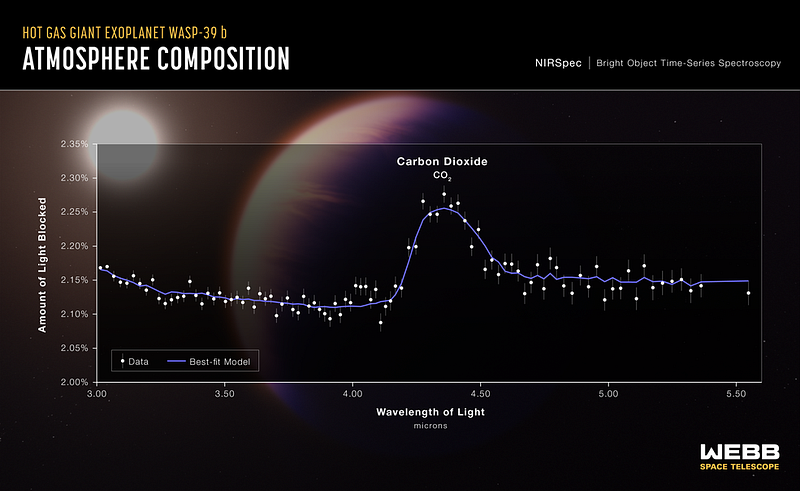Webb Telescope's Groundbreaking Discovery of Carbon Dioxide
Written on
Chapter 1: Introduction to Exoplanet Discovery
NASA's James Webb Space Telescope (JWST) has made remarkable strides in its early observations of distant space. As astronomers delve into the extensive data collected, intriguing findings are emerging from this revolutionary observatory. Research on gas giants, such as Jupiter and Saturn, has provided valuable insights into the evolution of our solar system. However, the question remains whether this evolutionary pattern is consistent across the universe.
The Webb Telescope's examination of a gas giant orbiting a Sun-like star located 700 light-years away offers crucial information regarding the formation and composition of similar celestial bodies. This research aligns with JWST's primary mission: to identify exoplanets that may possess habitable atmospheres. One notable target, the hot gas giant WASP-39 b, showcases a mass approximately a quarter that of Jupiter (similar to Saturn) and a diameter 1.3 times larger.
This planet's inflated size is largely attributed to its extreme temperature—around 1,600 degrees Fahrenheit (900 degrees Celsius). In stark contrast, the cooler gas giants within our solar system orbit much farther from the Sun. WASP-39 b, however, orbits significantly closer to its host star, at roughly one-eighth the distance between the Sun and Mercury.

Chapter 2: The Significance of Carbon Dioxide Detection
“As soon as the data appeared on my screen, the overwhelming carbon dioxide feature captivated me. It was a pivotal moment in exoplanet science.”
~ Zafar Rustamkulov, Study Team Member
In 2011, WASP-39 b was initially discovered, and subsequent observations by the Hubble and Spitzer telescopes indicated the presence of water vapor, sodium, and potassium in its atmosphere. However, the JWST's advanced infrared technology has now confirmed the existence of carbon dioxide in the planet's atmosphere.
The transiting nature of WASP-39 b made it an ideal candidate for atmospheric study. As the planet transited in front of its star, some starlight was blocked while some passed through its atmosphere.

A series of light curves captured by the Near-Infrared Spectrograph (NIRSpec) revealed fluctuations in brightness across three different wavelengths during the planet's transit on July 10, 2022.
Using transmission spectroscopy, scientists can analyze slight variations in brightness of transmitted light across a range of wavelengths to ascertain the composition of an atmosphere. The NIRSpec instrument enabled the team to observe the atmosphere of WASP-39 b.
The spectrum produced reveals a notable peak between 4.1 and 4.6 microns, marking the first clear, detailed detection of carbon dioxide in an exoplanet atmosphere. Previous observatories lacked the capability to identify such minute differences in color within the 3 to 5.5-micron range.
This spectrum is vital for quantifying gases like water and methane, along with carbon dioxide, in exoplanets. Although WASP-39 b's proximity to its star diminishes its potential as a host for life, this breakthrough opens doors for similar investigations on smaller rocky planets, which are much more likely to harbor life.
How Webb Found CO2 in an Exoplanet's Atmosphere - This video delves into the significant findings of the JWST regarding carbon dioxide detection in exoplanet atmospheres.
James Webb Telescope Discovers Atmosphere on Distant Super-Earth! - Explore the groundbreaking discoveries of the JWST as it uncovers the atmospheres of distant planets.
Complete research findings were published in the Journal of Nature. Stay updated with exciting developments like these by subscribing to my weekly newsletter for more insights.
